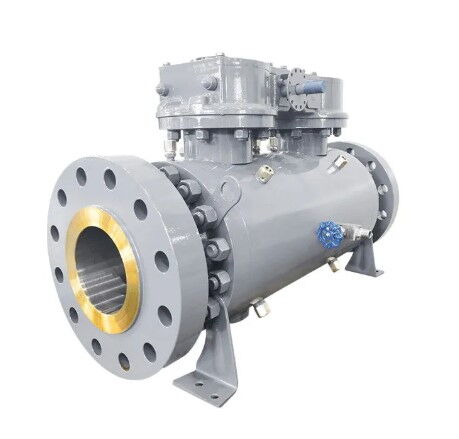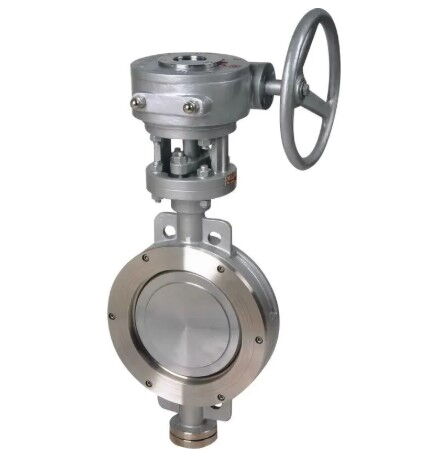In industrial piping systems, valves play a crucial role in controlling the flow of liquids or gases. Much like a faucet in a household, valves can be opened to allow fluid to pass through or closed to stop the flow. Among the various types of valves, ball valves and butterfly valves are two of the most commonly used. They are like a pair of partners, each with their own strengths, and are used in a wide range of applications. Today, let's take a closer look at these two types of valves, understand how they work, how they differ in use, and where each is best suited. This will help you determine which type of valve to choose.
Among the many types of valves, the ball valve is a very important player. It acts as a "spherical guardian" in the piping system, with its unique spherical structure enabling precise control of fluid flow. Whether it's cutting off or opening the flow, it can do so quickly and reliably. Let's delve deeper into the ball valve.

The core component of a ball valve is a sphere, which has a through-hole inside. The diameter of this through-hole matches the inner diameter of the pipe. When the through-hole of the sphere aligns with the direction of the pipe, fluid can flow smoothly through. When the sphere is rotated 90 degrees, making the through-hole perpendicular to the pipe, the fluid is cut off. This simple and efficient working method of the ball valve allows for the opening and closing of fluid flow by rotating the sphere via the valve stem.
The structure of a ball valve is relatively complex, mainly consisting of the valve body, valve core (sphere), valve stem, and sealing device. The valve core is installed inside the valve body and is connected to the external operating mechanism through the valve stem. The sealing device usually uses flexible materials, such as polytetrafluoroethylene (PTFE), which have good corrosion resistance and sealing properties. These materials ensure that the ball valve maintains good sealing performance under various working conditions.
The ball valve has excellent sealing performance, especially when dealing with liquids and gases without particulate impurities. It can almost achieve complete sealing. Since the sealing between the sphere and the valve seat is achieved through flexible materials, this type of sealing can effectively reduce wear and extend the life of the valve. In addition, the ball valve has low fluid resistance, with a resistance coefficient comparable to that of a pipe section of the same length. This means that there is minimal energy loss when fluid passes through, which is very important for systems that require efficient fluid transmission.
The operation of a ball valve is also very convenient and quick. It only takes a 90-degree rotation to switch from fully open to fully closed. This rapid opening and closing feature makes the ball valve perform well in situations that require frequent operation. However, the ball valve also has its limitations. Due to its relatively complex structure, it is more expensive, especially in the application of large-diameter valves. The limitations of size and opening/closing resistance make it difficult for ball valves to be large in diameter. Moreover, the sealing materials of ball valves usually cannot withstand high-temperature and high-pressure environments, which restricts their application in certain extreme working conditions.
Ball valves are widely used in industries such as oil, natural gas, chemicals, and pharmaceuticals, especially in situations that require high sealing performance and low fluid resistance. For example, in natural gas transmission pipelines, ball valves can effectively control the flow of natural gas, ensuring the safety and efficiency of the transmission process. In chemical production, ball valves are often used to control the transmission of corrosive liquids. Their good corrosion resistance and sealing performance can meet the stringent working condition requirements.
A butterfly valve uses a butterfly-shaped disc to control the flow of fluid. Despite its relatively simple structure, it is flexible in operation, quick in opening and closing, and can also regulate flow. It is particularly suitable for situations that require rapid operation and space-saving. Let's take a closer look at this flexible and efficient butterfly valve.

The opening and closing element of a butterfly valve is a disc-shaped butterfly plate, which is installed in the diameter direction of the pipe. By rotating the butterfly plate around the valve shaft, the butterfly valve can control the flow of fluid. When the butterfly plate is rotated to be perpendicular to the direction of the pipe, the fluid is completely cut off. When the butterfly plate is rotated to be parallel to the direction of the pipe, the fluid can flow smoothly through. The structure of a butterfly valve is relatively simple, mainly consisting of the valve body, valve seat, valve plate, and valve stem. All components are exposed and visible at a glance.
The working principle of a butterfly valve is similar to a "flipping plate." By rotating the butterfly plate, the direction of fluid flow can be changed or the fluid flow can be stopped. The rotation angle of the butterfly plate is usually between 0° and 90°. By adjusting the opening angle of the butterfly plate, the flow rate of the fluid can be regulated. This method of regulation gives the butterfly valve a significant advantage in situations that require precise control of flow rate.
The biggest advantage of a butterfly valve is its fast opening and closing speed, simple structure, and low cost. Due to its relatively simple structure and low material consumption, the butterfly valve has a small installation size and is very advantageous in the application of large-diameter valves. The opening and closing action of the butterfly valve is quick, with a small driving torque for a 90-degree reciprocating rotation. This makes the butterfly valve have good fluid control characteristics and closing sealing performance when cutting off, connecting, or regulating fluid flow.
However, the sealing performance of a butterfly valve is relatively weaker, especially under high-pressure and high-temperature conditions. The sealing of a butterfly valve usually relies on elastic materials such as rubber, which can easily deform under high temperature and pressure, leading to a decrease in sealing performance. In addition, the tightness and pressure-bearing capacity of a butterfly valve are not as good as those of a ball valve. Its maximum pressure is usually only up to 64 kilograms, while a ball valve can reach up to 100 kilograms.
Butterfly valves are widely used in industries such as water supply and drainage, heating, ventilation, and air conditioning (HVAC), power, and papermaking, especially in large-diameter piping systems. For example, in urban water supply systems, butterfly valves are often used to control the flow and pressure of water. Their fast opening and closing and flow regulation characteristics can meet the needs of the water supply system. In HVAC systems, butterfly valves are used to regulate the flow of air and water to ensure the normal operation of the system.
After gaining a detailed understanding of the characteristics of ball valves and butterfly valves, let's briefly compare them to see how they differ in terms of structure, performance, and application scenarios. This will help you better choose the valve that suits your needs.
Structure and Appearance: The valve core of a ball valve is a sphere, installed inside the valve body, with only a part visible to the naked eye. In contrast, the opening and closing element of a butterfly valve is a plate, with all components exposed. This structural difference makes the ball valve have better sealing performance than the butterfly valve, but the butterfly valve has a simpler structure and lower cost.
Sealing Performance: The sealing of a ball valve relies on the long-term compression of the valve seat on the spherical surface, usually using flexible materials, resulting in excellent sealing performance, especially when dealing with liquids and gases without particulate impurities. On the other hand, the sealing of a butterfly valve depends on elastic materials such as rubber, which have relatively weaker sealing performance and are not suitable for high-temperature and high-pressure environments.
Opening and Closing Method and Torque: During the opening and closing process of a ball valve, it operates under the clamping force of the two end valve seats, resulting in a larger opening and closing torque, especially as the nominal diameter increases, the difference in opening and closing torque becomes more significant. In contrast, the opening and closing of a butterfly valve require overcoming the deformation of rubber, resulting in a larger torque. Compared to gate valves and globe valves, the operation of ball valves and butterfly valves is faster and less labor-intensive.
Application Scenarios: Ball valves are typically used for liquids and gases without particulate impurities, where fluid pressure loss is minimal and sealing performance is good. However, they are more expensive and difficult to manufacture in large diameters. Butterfly valves, with their simple structure and low cost, have a larger adjustable range and are suitable for large-diameter piping systems. However, their sealing performance and pressure-bearing capacity are relatively weaker.
Choosing the right valve requires a comprehensive consideration of various factors, including the nature of the fluid, pressure, temperature, flow regulation requirements, and cost. Here are some suggestions for selecting valves:
Fluid Nature: If the fluid contains particulate impurities, a butterfly valve may be more suitable because the sphere and valve seat of a ball valve can be easily worn by impurities. For liquids and gases without particulate impurities, the ball valve has better sealing performance.
Pressure and Temperature: Ball valves are typically suitable for high-pressure and high-temperature environments, with a maximum pressure of up to 100 kilograms and a maximum temperature below 425 degrees. In contrast, butterfly valves generally have a maximum pressure of 64 kilograms and a maximum temperature below 150 degrees.
Flow Regulation Requirements: Butterfly valves can precisely regulate flow by adjusting the opening angle of the butterfly plate, making them suitable for situations that require precise flow control. Although ball valves can also regulate flow, they are not as flexible as butterfly valves.
Cost and Installation Space: Butterfly valves have a simple structure, low cost, and small installation size, making them suitable for large-diameter piping systems. Ball valves are more expensive and have a larger volume, but they offer better sealing performance and are suitable for situations with high sealing requirements.
Ball valves and butterfly valves are indispensable components in industrial piping systems, each with their own advantages and disadvantages, and are suitable for different application scenarios. Ball valves excel in situations that require high sealing performance and efficient fluid transmission due to their excellent sealing performance and low fluid resistance. Butterfly valves, on the other hand, have an advantage in large-diameter piping systems with their simple structure, low cost, and fast opening and closing speed. When selecting a valve, it is necessary to consider the specific working condition requirements, including the nature of the fluid, pressure, temperature, flow regulation requirements, and cost, to choose the most suitable valve type. This ensures the safe and efficient operation of the piping system.
By gaining a deep understanding of the structure, performance, and application scenarios of ball valves and butterfly valves, we can better leverage the advantages of these two types of valves to provide reliable fluid control solutions for industrial production. It is hoped that the introduction in this article will help everyone better understand and choose the right valve to ensure the stable operation of industrial piping systems.
